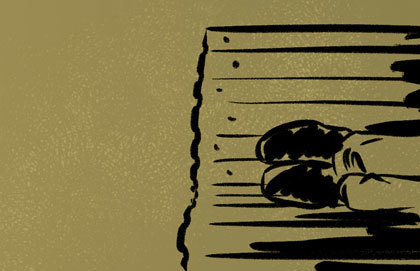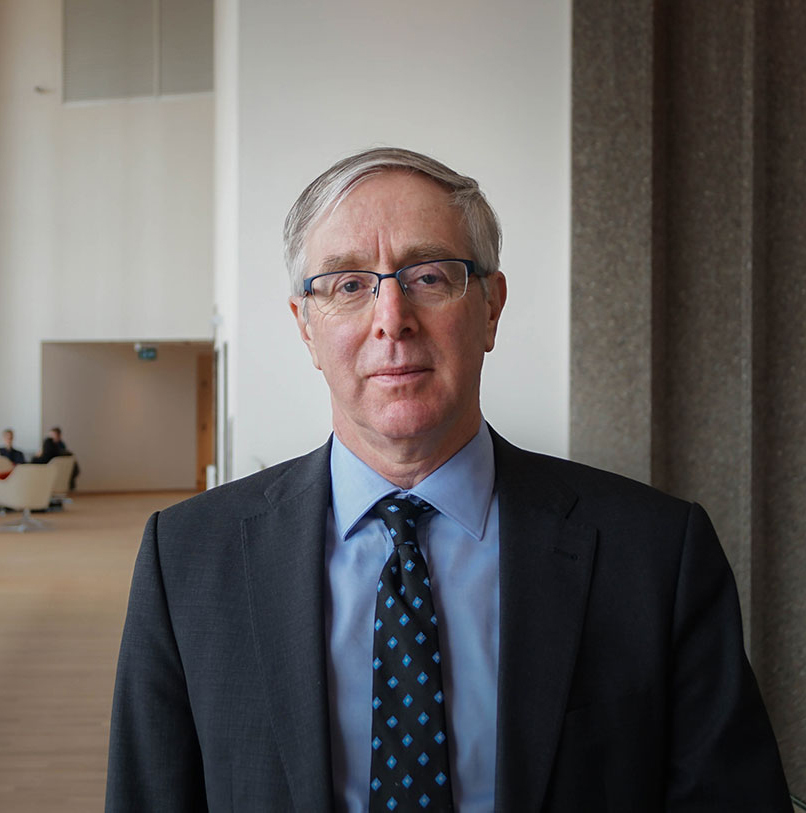This is the third part of Convivium's series on homelessness, addiction, and mental illness. Click here to read part one: "Opening the Door on Homelessness."
In the National Gallery of Canada’s current retrospective of Toronto photographer Dave Heath’s “A Dialogue With Solitude,” the face of social isolation stares black and white from the wall.
It is the face of Erin Freed, who appears to have been still shy of school age when Heath captured her image on a 1963 New York City street. Dark hair dishevelled by poverty, not play—it appears evident—droops over and occludes one eye, shifting attention to the pointillist bible black lower eyelashes of the other.
A bright white circle of forehead draws our gaze upward only to push it down again in an oblique line to muddy stippling of the child’s right cheek that could be either renewal of old injury or some form of anonymous infection. Much as we might humanely recoil from the mystery of childhood suffering, there is no avoidance Erin’s eyes. They won’t let us off the hook just because we’re “neutral observers” of art.
Part of their power comes from the variant shades of grey that are a technical testament to photographic master craftsmanship. Part of it comes from knowing inside ourselves that we see variations of eyes just like them almost every day on virtually every city centre street in Canada.
The sight is fleeting because all too often we see them, and then rapidly avert our own eyes, from the powerful, silent evaluation of a world in which everything, everywhere, everyone emerges from solitary fear, hooded loneliness, and brutalizing shame.
The true power of Erin Freed’s photo, though, comes from its capacity to catch us in the nowhere-better-to-go sophistication of a major gallery show; to force us to stand; to force us to see. Heath’s genius as a photographer comes from him having looked out at the world through the same eyes as Erin – eyes we would rather not look into if we can avoid it.
“The central motif of Dave Heath's life has been a dark and pervasive feeling of rejection,” a 2016 New York Times obituary quoted from an old exhibition catalog. “His sense of emotional homelessness was at once a great weight and a motivation — a source of personal pain and of deep philosophical insight.”
Emotional homelessness. The phrase encapsulates Heath’s own historical trauma of being abandoned before his first birthday by his father, and before his fifth birthday by his mother, who left him on a doorstep in his native Philadelphia and vanished forever from his life. But it has endlessly rippling implications for the wide world as well, including Canada’s homelessness economy that runs on an estimated $33.5 billion dollars each year.
We know, in a kind of we’re-pretty-sure way, what homelessness means. We can compute, with a fair degree of accuracy, the nose count implications of not having a sound floor, four solid walls and a safe roof under which to sleep. We can do the sums for the amounts contributed to that total by the triangulated afflictions of mental illness and substance addiction. But emotional homelessness? Where’s the ledger entry for that?
It’s not an insignificant question. In fact, as I discovered during research in the field late last year and earlier this, it bedevils even the most committed, hardest-working, creative souls in the homelessness universe. It finds one answer in the conviction that the conundrum is, first and foremost, one of adequate housing stock. It finds another answer in an emphasis on community and connection. It would be a cheap journalistic trick to make it sound as though the answers are in tension, much less opposition. It’s not even chicken and egg: more of a double helix that spirals in unison around a central core of love of neighbour.
For Jeff Neven, executive director of Hamilton’s Indwell, love of neighbour that is Christian charity ineluctably drives the moral purpose of investing in properties that are transformed into sheltering homes for those most in need.
“I’ve never known anyone whose mental health was improved by sleeping under a bridge,” Neven says during a conversation at Indwell’s offices in one of the city's poorest neighbourhoods. “We design and maintain beautiful buildings and we let people know, verbally and visually with the building that they get to live in, that it is a beautiful building and that they are worth it.”
Indwell’s emphasis on quality housing stock, he emphasizes, is a means to an end. It’s the vital means of communicating the essential human dignity that dwells identically in corporate chief executive and substance addicted street person. For those who have stumbled, for those who have fallen, it’s also an effective means to build, or re-build, necessary skills not just to recover but to renew.
“Our expectation is that those who come to live in our buildings are going to honour them, and maintain them, and, oh, ‘by the way, you’re going to pay your rent. We’re going to start with that expectation.’ About 99.5 per cent of our rent gets paid. We have almost no vandalism. Why? Because we see our tenants as our number one asset. When you treat people as your number one asset, they respond really positively.
“If you tell people ‘we don’t think you’re worthy of a good unit so we’re going to put you in a dump, and we don’t even believe you’re going to pay your rent because you’re kind doesn’t take care of where you live, so you’ll probably trash it,’ people will live up to that expectation. They will trash it. They won’t pay the rent. When you establish a relationship and set expectations, people live up to those expectations.”
Emotional homelessness, then, might be defined in part as the absence of a place to dwell where just such relationships, and the expectations they engender, can flourish. Or as Neven puts it: “If you don’t have a support network that catches you when you need it to, you don’t stop until you hit the bottom. I actually believe the only way to overcome poverty is in those relationships where people become to do what’s good for others.”
And those relationships, he says, must be grounded not just in provision of basic shelter but in the beauty of home as an ideal: in the overcoming of isolation surrounded by tangible architecture of faith, hope and charity.
“Our architecture…it’s really important to us. Our buildings are a metaphor for life in the midst of darkness. We physically cut openings to bring in light. That value permeates all we do, all that we are. Every day is a working out of that value, and inviting more people in.”
Across the country in Calgary, on a day of grey clouds and whipping snow, Earl Thiessen sits behind the desk in his office and invites me into the story of how he went from being a homeless addict to program manager for Oxford House, a non-profit that provides supportive housing in homes across Calgary for those who’ve been sober 14 days or longer. Thiessen’s story starts a step or two before the stage of repair Jeff Neven talks about. Home, for Thiessen, means first coming home not to a building, but to yourself.
“You know the drunken Indian you’ve seen on the street corner downtown?” he asks. “I was the drunken Indian. I ended up selling crack to feed my alcohol addiction. A lot of people laugh at me for that,” Thiessen says.
He laughs when he says it, though it is laughter of relief. Genial, open-hearted, better than a decade out from lasting sobriety, he is a man whose scar tissue is not just physical, not mere aide to memory, but a life-saving amulet. Paradoxically, its most potent power seems to be to ward off the shame that burned into him with every single laceration.
“I remember my ex (wife) telling me she saw me downtown with my friends. She was with my second oldest son. I was just wrecked. She had to turn around so that my son didn’t recognize me. It broke my heart to hear that.
“I know what shame is. I know what it’s like to wake up in the middle of a park going ‘where the hell am I?’ There’s kids running around, and they see you, and you feel so ashamed. You get up, you kind of tuck your tail between your legs, and you walk away. The shame is horrible. It’s a horrible way to live.”
Yet he recounts the shame and the horror matter-of-factly, admitting without hesitation to the damage done to his relationships with his loved ones. He lays the facts out as a highly skilled dealer lays out cards. You play the cards. The cards play you. Wins and losses. Carry on.
“I have children 27 and 21, and then my kids 8 and 6 at home. The two oldest, addiction ruined my relationship with their mothers. I apologized to both of them. I said, ‘There’s nothing I can do about the past except apologize. We need to move forward from here.’”
As text, on a screen, the words might convey detachment gusting to coldness. Anything but. As Thiessen speaks them, they resonate with kindness born of wisdom won hand-to-hand. Critical to them is the recognition that while relationships and human engagement are vital bulwarks against social isolation, they can perversely be catalysts for the condition identified by generations of blues singers as being “down so long the bottom looks like up from here.”
For Thiessen, a horrific rupture in his family life when he was teenager became a vortex that began the downward pull. Born in Saskatoon to a mother from the Meadow Lake Reserve and a father “from Mennonite country,” he moved to Calgary as a child. He was winning provincial wrestling championships and playing high school football when his alcohol abuse began tearing into his parents’ lives. Then into his. He was the life of the party. Next, he was a “functioning” alcoholic. Fast forward to being kicked out of his brother’s house and starting to steal from friends. Fade to black with the drive downtown.
“I had nowhere to go. I called my brother. He said, ‘I don’t know what to tell you.’ I said, ‘Can we go for coffee and figure out a game plan?’ The game plan ended up being him dropping me off at the drop-in centre downtown. I was terrified. I’d never been in a situation like that before.”
Homeless, on the street, it took but a few hours for camaraderie to become relationships that were leg-hold traps camouflaged as protection from isolation: “Within three hours of being down there, I made friends taking guys out to smoke a joint and buying a couple of bottles of beer. It just progressed from there.”
Progress turned out to be multiple addictions so severe they brought on tongue-chewing seizures, being sentenced to two years less a day in provincial prison after spending seven months in the Calgary remand centre on drug charges.
“I walked in (to jail) and half the people in there were guys I knew from the street. So, again, right away, I fit in.”
In all, there were 31 trips through the combined cycle of detox and attempted recovery. It led to the day he stormed away in an intoxicated rage, shouting obscenities at a woman he loved, and returning later to apologize. She had been stabbed to death a few feet from where he’d left her.
“Four guys stabbed her as part of a gang initiation. They caught an artery. They killed her. She bled to death on a bench.”
That was the beginning of the turn toward the light, though it was still a long, long way away. It finally broke in the dark, ugly form of an overbearing city cop Thiessen admits he mouthed off to, and from whom he took a severe beating. Notwithstanding him having 11 outstanding arrest warrants, a judge gave him a last-ride roundup lecture and directed him yet again to detox-rehab.
“I knew when I was walking up to (the treatment centre) with my broken foot and my black eye, after being given that chance and released on my own recognizance, that I was done. I did not want to hit the ground again, and smash my head again, and chew through my tongue again. I could not do that anymore. I sobered up November 13, 2007.”
Two crucial convictions emerge as Thiessen talks, both intricately stitched into what Dave Heath called the dialogue of solitude. One is his firm belief that the path out of homelessness, addiction, and to some extent their spectral cousin mental illness, requires a willingness born of sheer physical urgency, to dive deep into the solitariness of self that is so destructively absent in social isolation.
The second conviction, congruent though seemingly contradictory, is the essential need to provide not just shelter, not just treatment, but community at the very beginning of the process.
“When I walked into treatment, I said ‘I walked in here alone and I’ll be walking out alone. If I make friends while I’m here, perfect. But I know the success rate, and I’ll be leaving alone because the most important person in this room to me right now is me.’
“You can’t walk up to a homeless person or an addict and say ‘here, let me save your life for you.’ They’ll walk over you, the way I stepped over my own mother and father to get my booze. They have to hit a point, even have just a fleeting thought, that they need to change their lives. Then there needs to be one person there to say, ‘hold my hand, let me walk you through this and open the door for you.’ But the addict, the homeless person, has to understand they’re doing this by themselves, for themselves.”
Conventional wisdom calls that hitting bottom. But as Thiessen – and others I spoke with – made abundantly clear, that’s a misguided phrase. The only bottom addicts really hit is if they wind up in a grave. Otherwise, it’s a series of bone – and spirit – shattering bounces from intoxication to detoxification to recovery to relapse or, in the best of all possible worlds, life-long release.
The space between bounces, Thiessen intuited as he moved through his own healing, invariably involves institutional gaps in the time between detox and recovery. Specifically, addicts who go through a week-long detox are invariably given an appointment card to show up for follow-up recovery four, five or six weeks or more down the road.
An innovation born from Thiessen’s scar tissue of experience, and now being run as a pilot project by Oxford House, is the development of “pre-treatment” housing to bridge the gap between the end of detoxification and the start of recovery. It allows a small group of men and women who’ve just come in out of the homelessness cold to live in community until their treatment dates start. The dialogue of solitude has room to become a conversation of co-responsibility while minimizing the ever-present threats of co-dependence.
“The usual routine is going to detox, get healthy, sign up for treatment. So (the addict) says “Yeah, I’ll sign up for treatment that’s three months down the road. That gives me three months to use.’
“The idea behind pre-treatment is that when you leave the house, you leave with somebody else, and both of you come back together. I’ve been in this industry long enough to know that there are always going to be people who fall off. It’s going to happen. But if you go out and come back together, you have someone who isn’t going to drag you down because he’s honest about not wanting to hit the ground. You have to have somebody that you can lean on.”
Thiessen lets the common sense wisdom of his words come into focus like something in a room – a lamp, a letter, a photograph – being belatedly noticed for the first time. Then he laughs the small chuckle of a man living work he loves.
“Sometimes I ask myself how come it took a guy who was homeless for seven years, an ex-convict, a person in recovery, to figure out what should have been figured out 40 years ago. It would have helped me the first time I went through treatment that’s for sure. But then I think of what it took, and what it meant, to get clean and sober, and how everybody around me or that I care about can benefit from that. I get to help people like me.”
I get to help people like me. The sentence rolls around in my mind in the days and weeks after the interview with Earl Thiessen. And then I come across Dave Heath’s inescapable photograph of Erin Freed’s face on a 1963 New York street, and look at those long-ago eyes of a pre-school shy child already filled with the pervasive pain of rejection, the deep well of all who suffer the inhuman violation that is emotional homelessness. And I say in the solitude of the dialogue that is prayer: “Please, God, please. Bring them home, wherever that beautiful home might be.”






